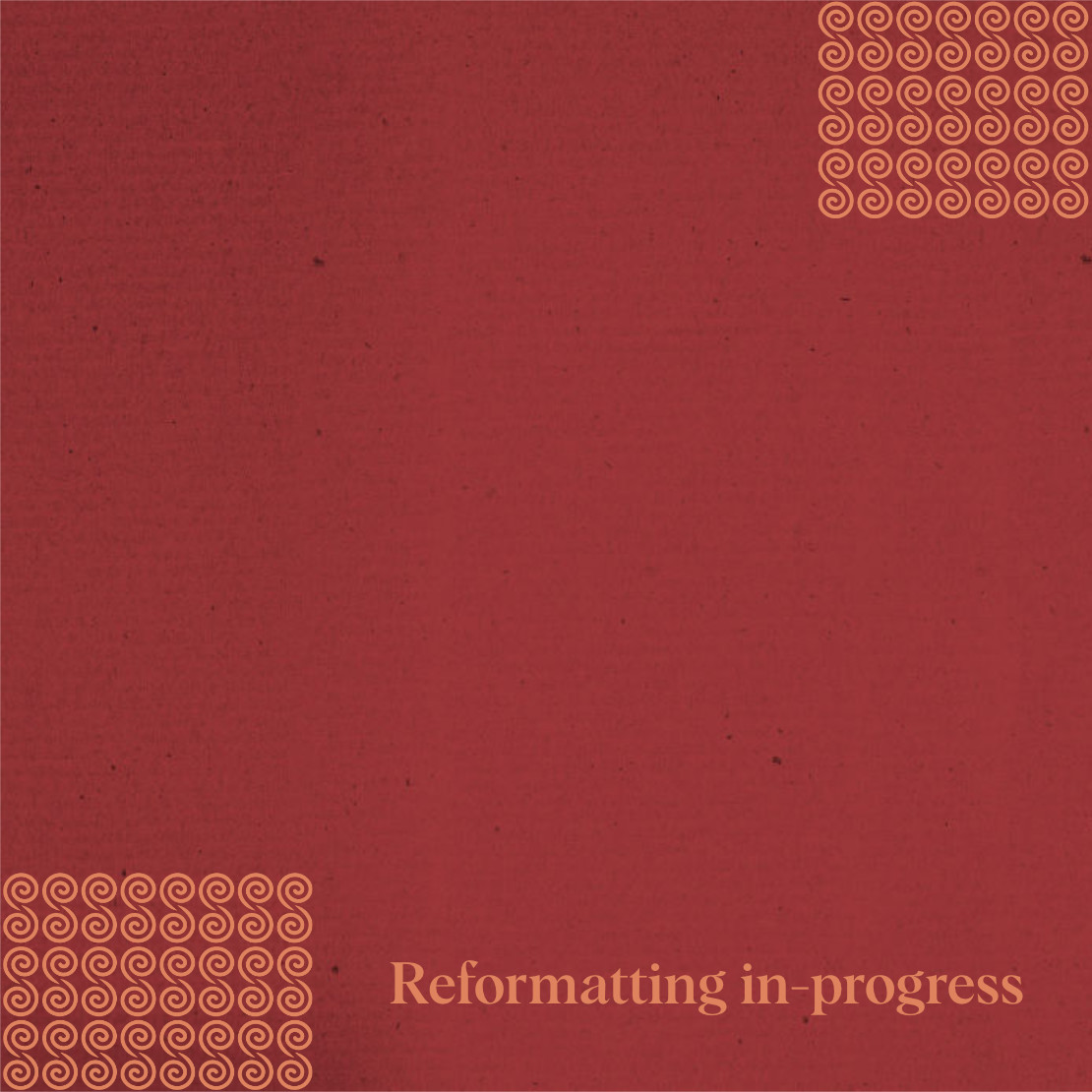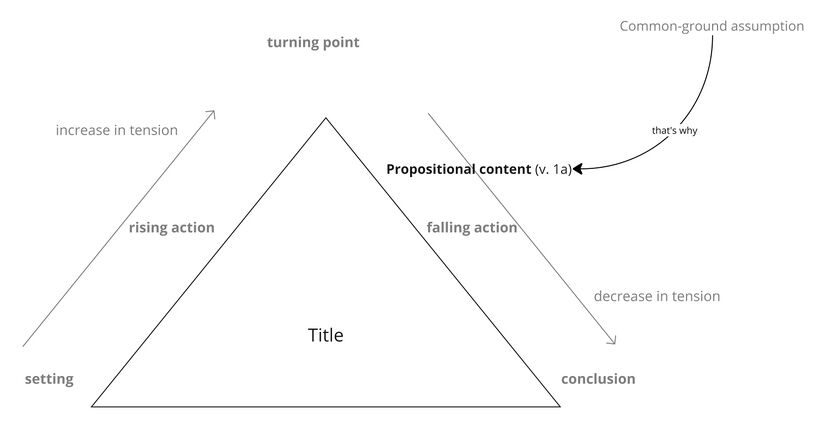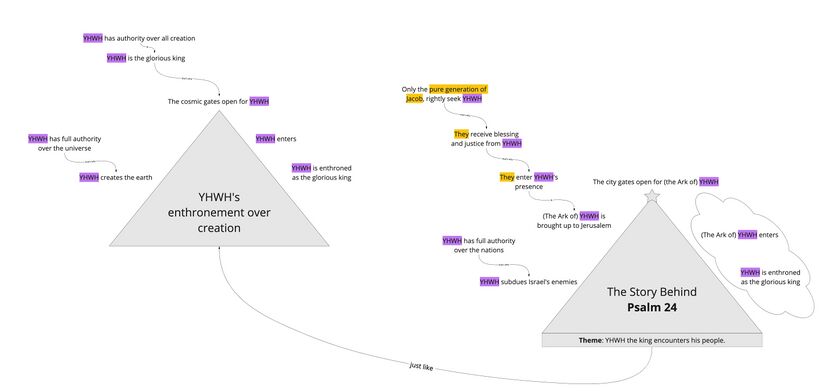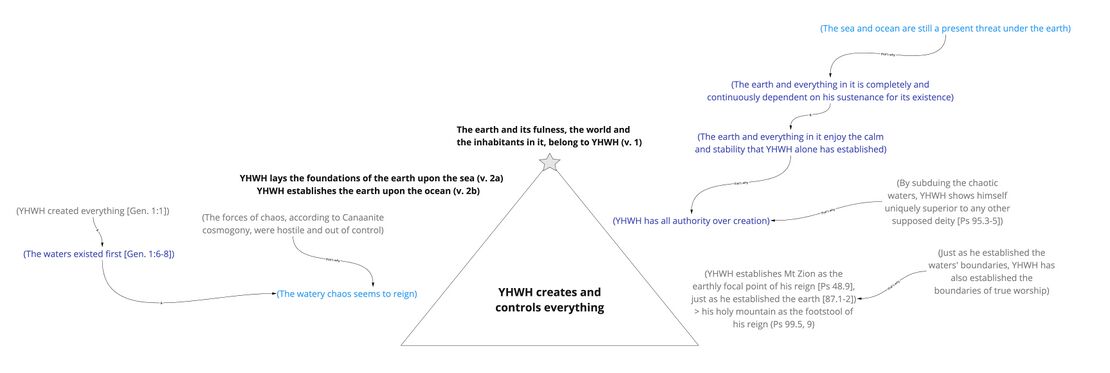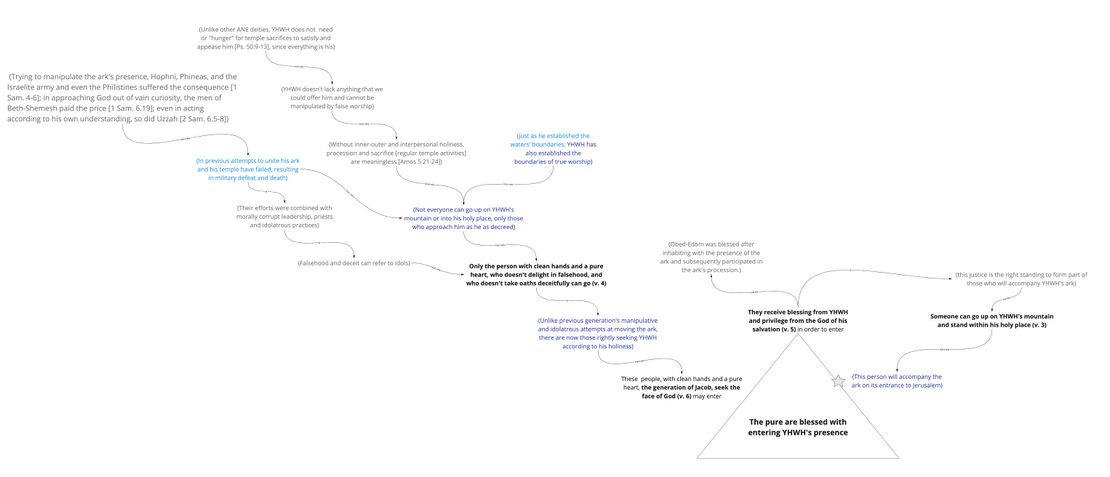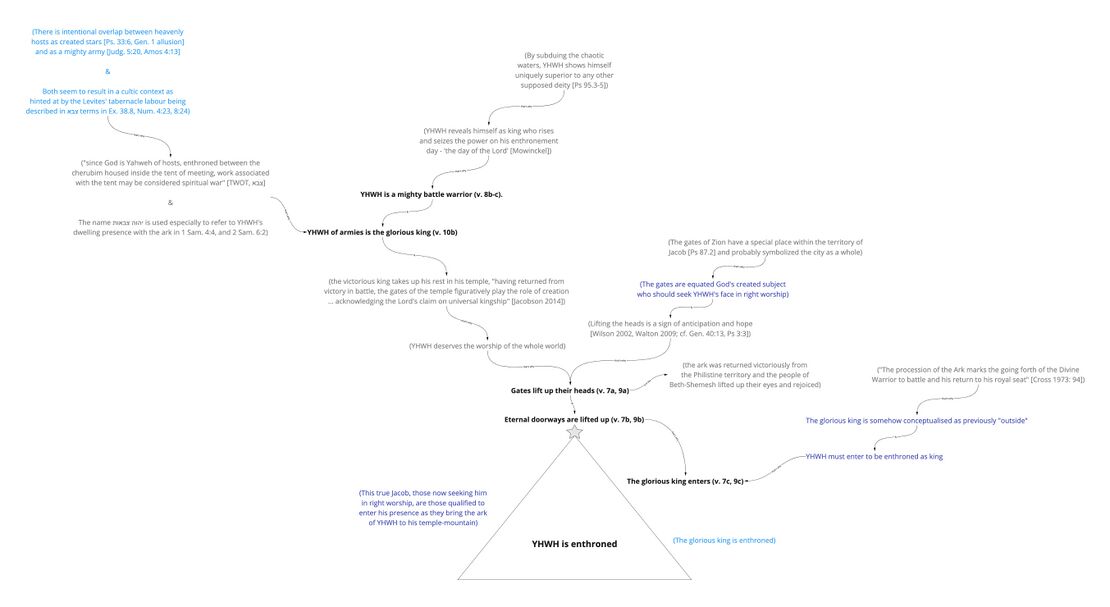Psalm 24 Story Behind
About the Story Behind Layer
The Story Behind the Psalm shows how each part of the psalm fits together into a single coherent whole. Whereas most semantic analysis focuses on discrete parts of a text such as the meaning of a word or phrase, Story Behind the Psalm considers the meaning of larger units of discourse, including the entire psalm.
The goal of this layer is to reconstruct and visualize a mental representation of the text as the earliest hearers/readers might have conceptualized it. We start by identifying the propositional content of each clause in the psalm, and then we identify relevant assumptions implied by each of the propositions. During this process, we also identify and analyze metaphorical language (“imagery”). Finally, we try to see how all of the propositions and assumptions fit together to form a coherent mental representation. The main tool we use for structuring the propositions and assumptions is a story triangle, which visualizes the rise and fall of tension within a semantic unit. Although story triangles are traditionally used to analyze stories in the literary sense of the word, we use them at this layer to analyze “stories” in the cognitive sense of the word—i.e., a story as a sequence of propositions and assumptions that has tension.
Summary Triangle
The story triangle below summarises the story of the whole psalm. We use the same colour scheme as in Participant Analysis. The star icon along the edge of the story-triangle indicates the point of the story in which the psalm itself (as a speech event) takes place. We also include a theme at the bottom of the story. The theme is the main message conveyed by the story-behind.
| Story Triangles legend | |
|---|---|
| Propositional content (verse number) | Propositional content, the base meaning of the clause, is indicated by bold black text. The verse number immediately follows the correlating proposition in black text inside parentheses. |
| Common-ground assumption | Common-ground assumptions[1] are indicated by gray text. |
| Local-ground assumption | Local-ground assumptions[2] are indicated by dark blue text. |
| Playground assumption | Playground assumptions[3] are indicated by light blue text. |
| The point of the story at which the psalm takes place (as a speech event) is indicated by a gray star. | |
| If applicable, the point of the story at which the psalm BEGINS to take place (as a speech event) is indicated with a light gray star. A gray arrow will travel from this star to the point at which the psalm ends, indicated by the darker gray star. | |
| A story that repeats is indicated by a circular arrow. This indicates a sequence of either habitual or iterative events. | |
| A story or event that does not happen or the psalmist does not wish to happen is indicated with a red X over the story triangle. | |
| Connections between propositions and/or assumptions are indicated by black arrows with small text indicating how the ideas are connected. | |
| Note: In the Summary triangle, highlight color scheme follows the colors of participant analysis. | |
Background ideas
Following are the common-ground assumptionsCommon-ground assumptions include information shared by the speaker and hearers. In our analysis, we mainly use this category for Biblical/Ancient Near Eastern background. which are the most helpful for making sense of the psalm.
- YHWH created everything and shows his authority and sovereignty over all creation
- After doing so, YHWH assumes his position of rest in his cosmic temple
- Mount Zion represents both the centre of creation and the temple-city of YHWH's special presence
- The temple/Ark presence involved 'military' language even in worship and sacrifice
- The Israelites had a history of trying to manipulate the ark and to worship according to their own understanding, not recognizing the boundaries of YHWH's holiness
- Those who will now accompany the ark's entrance to Jerusalem must do so in right worship and in light of YHWH's holiness
Background situation
The background situation is the series of events leading up to the time in which the psalm is spoken. These are taken from the story triangle – whatever lies to the left of the star icon.

Expanded Paraphrase
The expanded paraphrase seeks to capture the implicit information within the text and make it explicit for readers today. It is based on the CBC translation and uses italic text to provide the most salient background information, presuppositions, entailments, and inferences.
| Expanded paraphrase legend | |
|---|---|
| Close but Clear (CBC) translation | The CBC, our close but clear translation of the Hebrew, is represented in bold text. |
| Assumptions | Assumptions which provide background information, presuppositions, entailments, and inferences are represented in italics. |
| Text (Hebrew) | Verse | Expanded Paraphrase |
|---|---|---|
| לְדָוִ֗ד מִ֫זְמ֥וֹר לַֽ֭יהוָה הָאָ֣רֶץ וּמְלוֹאָ֑הּ תֵּ֝בֵ֗ל וְיֹ֣שְׁבֵי בָֽהּ׃ | 1 | By David, a psalm. Since YHWH alone created everything The earth and its fullness belong to YHWH, the world and the inhabitants in it, so he doesn't lack anything that we could offer him, nor can we manipulate him as we tried when we brought the ark into battle at Aphek, |
| כִּי־ה֭וּא עַל־יַמִּ֣ים יְסָדָ֑הּ וְעַל־נְ֝הָר֗וֹת יְכוֹנְנֶֽהָ׃ | 2 | because he founded it, the world, upon seas and established it upon oceans, thereby establishing the waters' boundaries and his sovereign authority . |
| מִֽי־יַעֲלֶ֥ה בְהַר־יְהוָ֑ה | 3 | In previous attempts to unite his ark and his temple, however, we have tried to manipulate the ark's presence, and we saw how Hophni, Phineas, the men of Beth-Shemesh and Uzzah suffered the consequences of doing so according to their own understanding. As we now bring the ark into Jerusalem, we are determined to do it rightly this time. So, Who may go up on the mountain of YHWH? And who may stand within his holy place? |
| נְקִ֥י כַפַּ֗יִם וּֽבַר־לֵ֫בָ֥ב וְלֹ֖א נִשְׁבַּ֣ע לְמִרְמָֽה׃ | 4 | Unlike the Israelite army who tried to manipulate the ark's presence being carried by Hophni and Phineas, the answer to who may enter his presence is: only One with clean hands and a pure heart, and in contrast to the actions of Hophni and Phineas, who were morally corrupt and unfit for priestly worship of YHWH as they treated their duties with contempt, the answer is: one who hasn't taken delight in falsehood, nor taken an oath deceitfully - falsehood and deceit being euphemisms for idols. So, clean hands and a pure heart represent ethical purity, and rejection of idolatry is part of proper worship. |
| יִשָּׂ֣א בְ֭רָכָה מֵאֵ֣ת יְהוָ֑ה | 5 | As for this person with moral and religious integrity He will receive blessing from YHWH just as Obed-Edom was blessed after inhabiting with the presence of the ark and privilege from the God of his salvation- that is, the right standing to form part of those who will accompany YHWH's ark, just as Obed-Edom participated in the ark's procession. |
| זֶ֭ה דּ֣וֹר דֹּרְשָׁ֑יו | 6 | Previously Israel tried to manipulate YHWH's presence and did not respect his boundaries of holiness Such, that is, with moral purity and the ability to accompany the ark and enter YHWH's presence, is the generation of those now seeking him, of those who seek your face, the generation of Jacob. Selah. |
| שְׂא֤וּ שְׁעָרִ֨ים ׀רָֽאשֵׁיכֶ֗ם וְֽ֭הִנָּשְׂאוּ פִּתְחֵ֣י עוֹלָ֑ם וְ֝יָב֗וֹא מֶ֣לֶךְ הַכָּבֽוֹד׃ | 7 | This true Jacob, those now seeking him in right worship, are those qualified to enter his presence as they bring the ark of YHWH to his temple-mountain - an image of the entire cosmos. After subduing anything chaotic in creation, he is like a returning victor from battle entering his capital city, just as the ark was returned victoriously from the Philistine territory and the people of Beth-Shemesh lifted up their eyes and rejoiced, so Lift up your heads in expectation and hope, gates, you true worshippers who seek YHWH's face, and be lifted up to open and welcome him, eternal doorways, so that the glorious king might enter to be enthroned, victorious, over his cosmic temple! |
| מִ֥י זֶה֮ מֶ֤לֶךְ הַכָּ֫ב֥וֹד יְ֭הוָה עִזּ֣וּז וְגִבּ֑וֹר יְ֝הוָ֗ה גִּבּ֥וֹר מִלְחָמָֽה׃ | 8 | Who is this glorious king? The one who created and sustains the world, YHWH, has shown himself to be a mighty one and a warrior, superior over any other god, assuming his rest in the cosmic temple after establishing order in the cosmos. YHWH is a battle warrior, whose special presence is manifested by the Ark having returned from battle to enter his temple-mount. |
| שְׂא֤וּ שְׁעָרִ֨ים ׀רָֽאשֵׁיכֶ֗ם וּ֭שְׂאוּ פִּתְחֵ֣י עוֹלָ֑ם וְ֝יָבֹא מֶ֣לֶךְ הַכָּבֽוֹד׃ | 9 | Lift up your heads, gates of creation, indeed, of all his created subjects, and lift up to open and, eternal doorways, so that the glorious king might enter! |
| מִ֤י ה֣וּא זֶה֮ מֶ֤לֶךְ הַכָּ֫ב֥וֹד יְהוָ֥ה צְבָא֑וֹת ה֤וּא מֶ֖לֶךְ הַכָּב֣וֹד סֶֽלָה׃ | 10 | Who is this glorious king? The Lord of all creation who has revealed himself as YHWH of armies, sitting enthroned between the cherubim on the ark, and established his special presence on Mount Zion, He is the glorious king, to whom belongs the worship of the whole world. Selah. |
There are currently no Imagery Tables available for this psalm.
Bibliography
Footnotes
- ↑ Common-ground assumptions include information shared by the speaker and hearers. In our analysis, we mainly use this category for Biblical/ANE background - beliefs and practices that were widespread at this time and place. This is the background information necessary for understanding propositions that do not readily make sense to those who are so far removed from the culture in which the proposition was originally expressed.
- ↑ Local-ground assumptions are those propositions which are necessarily true if the text is true. They include both presuppositions and entailments. Presuppositions are those implicit propositions which are assumed to be true by an explicit proposition. Entailments are those propositions which are necessarily true if a proposition is true.
- ↑ Whereas local-ground assumptions are inferences which are necessarily true if the text is true, play-ground assumptions are those inferences which might be true if the text is true.
